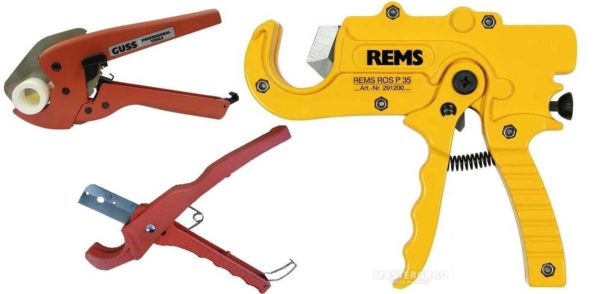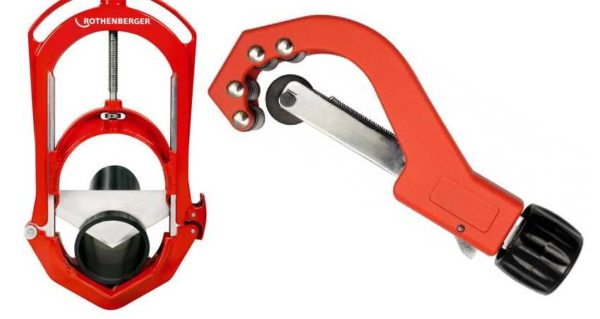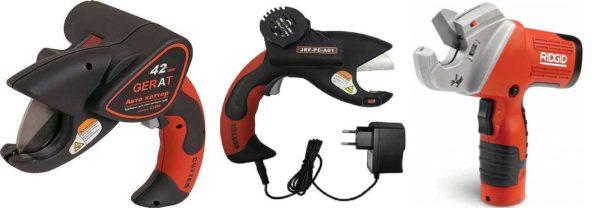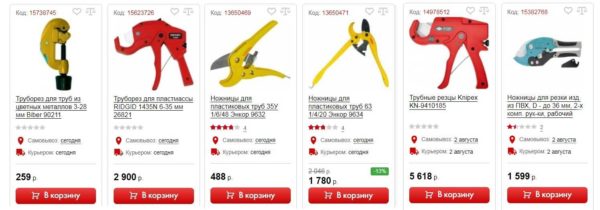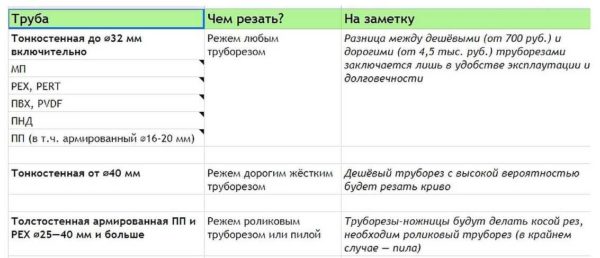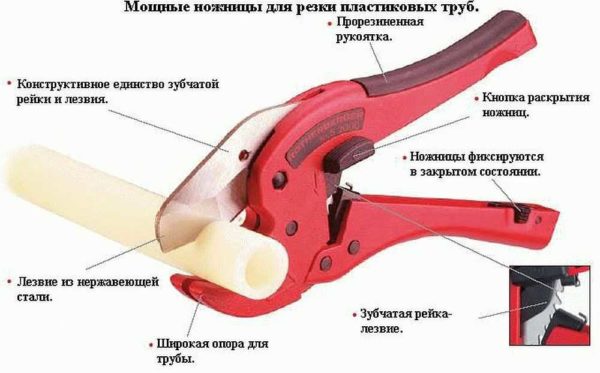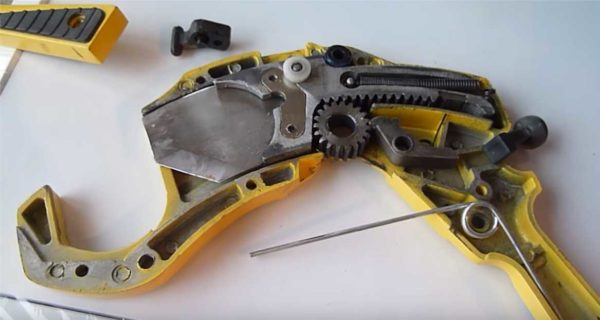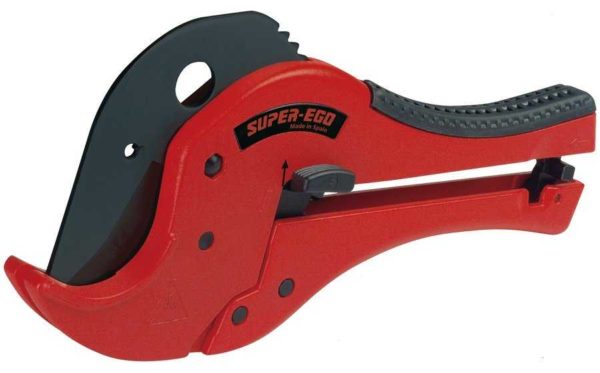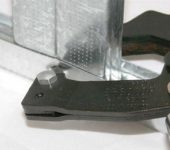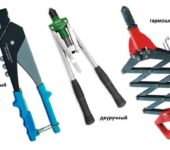Shears for cutting pipes: polypropylene (PPR), plastic, metal-plastic
Plastic plumbing and heating - this is no longer surprising to anyone. But the pipes must be cut. With what? There is a tool for this, which is usually called pipe scissors. And also - with a cutter, pipe cutter. There are several designs that look different, although they serve the same function. And the price can be different - from several hundred rubles to ten thousand or more.
The content of the article
Types of pipe scissors
Increasingly, the distribution of cold and hot water pipes, even heating, is made with plastic, polypropylene, metal-plastic pipes. They are easier to install, but a smooth cut is required for a high-quality connection. And they cut pipes with special scissors or a cutter. There are different types, so first you need to find out about them.
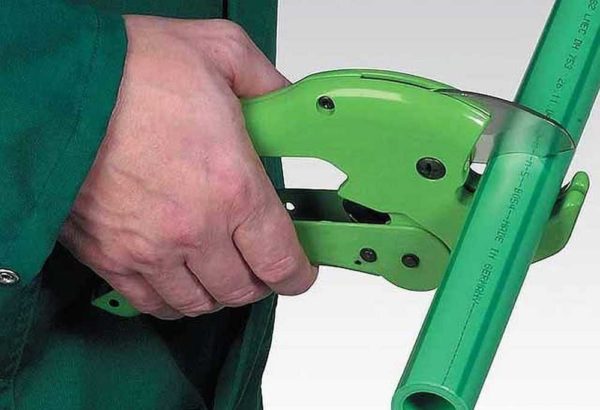
For the installation of plastic or polypropylene water pipes or heating systems, pipe scissors are required
Actually, the design is not that important. It is important how smooth the cut can be made by the pipe scissors, what diameters they cut, with what materials and types of reinforcement they work. But let's start with the types and types of structures.
Mechanical, with manual "drive"
There are options for home use and professional. But even if you only need for repair or for yourself, it is better not to take absolutely cheap ones. A smooth cut even on a thin pipe will not work.
- Pipe scissors. They are very similar in shape to ordinary ones. Naturally, the body is more durable, the blades are made of stronger steel, not even, but with rounded curves - to make it easier to lay the pipe. Large diameters, and dense materials (polypropylene) are cut with great difficulty, even if the description states a diameter of 40 mm. For small-diameter pipes, they are suitable, for large ones, either a larger size or another type is needed. May be:
- With a return spring (pictured below left). You will have to cut off exclusively due to the strength of the hands. Of the auxiliary mechanisms, only the return spring, which returns the flattened blades to the open position. If you want to pump up, this model is for you. Even thin-walled polyethylene is very difficult to cut. Is that for flexible floor heating pipes will go.
- With a ratchet (ratchet). Much less effort is required as the toothed element switches, which increases the applied force, extends and lowers the blade. The weak point is the ratchet mechanism. These are the parts that move the blades when you push down on the handles. Often it is in it that the problem is - the spring jams, breaks, etc.
- Pistol (or elephant). It takes a little more time to cut, but less effort is needed. The mechanism inside is more complex, with gears. This reduces the effort required. They are more expensive. Nevertheless, it is not worth taking cheap ones, since the gears are made of a soft, incomprehensible alloy and they wear out after a couple of days of work.
- Roller pipe cutters. This is not to say, straight scissors for cutting polypropylene pipes. They are a C-shaped body with a retractable cutting roller element. The pipe is placed in the body, fixed, and then cut by a roller along the circumference. Even a thin wall cannot be cut in one go. The roller is gradually extended more and more, scrolling the pipe. For reinforced and thick-walled pipes - an excellent option. The cut is good, without large deviations.
- Guillotine for cutting pipes.Such a device is used for large diameters. Usually these are main pipes that are not used in everyday life.
Which design is better to choose? If you are only for home use, it makes sense to buy the first type. Easy to work, although they require effort, but for plastic plumbing assembly or polypropylene systems not much to cut. You can also consider roller pipe cutters. Also an inexpensive and oversized tool. The guillotine is generally not needed by private traders, and the pistol is not so relevant because of the high price.
With electric drive
Electric and cordless pipe cutters are already a tool for professional use. Good because it does not require physical effort. All you need to do is press the button and hold the pipe straight while the device is working. Electric shears are usually equipped with a button to return the knife to its original position. Electric pipe shears can be:
- Rechargeable.
- Mains powered.
They are most similar in design to the "pistol" model. They look more massive due to the plastic protective case. And the motor and batteries (if any) also need to be hidden somewhere. But since almost no effort is required during work, the weight is not critical (from 1 to 2 kg).
Price range
Let's talk about pricing for the sake of completeness. The cheapest scissors for polypropylene pipes are in the form of scissors. There are copies here for $ 5 or so. There are also more expensive - $ 50 and more. It should be said right away that the cheapest are suitable for cutting thin-walled plastic or unreinforced polypropylene of small diameter. Not more than 14-16 mm.
Roll cutters are also available at a very low cost - even less than $ 5. Their purchase is a dubious undertaking. Too much play on the cutting element will not give you normal results. And the body is not clear from what, poor grip of the pipe. In general, not worth it. Even for home use, it is better to take at least an average price range.
Pistol-shaped scissors for polypropylene pipes are more serious equipment. Provided that the movement is made of hardened steel and not silumin or other obscure alloys. The minimum cost is about $ 30-40.
How to choose pipe shears
For home use or for occasional use, a mechanical pipe cutter is usually taken. The design is chosen so that it is "cheap and reliable". The most commonly purchased ratchet scissors. In principle, a justified choice. Beginning professionals also work with them. You just need to choose the right model.
In general, you can give the following recommendations for choosing the type of pipe cutters. A thin-walled pipe without reinforcement of any material is cut with a normal quality pipe cutter or scissors, regardless of the design. Limitations on diameter - 32 mm, on wall thickness - up to 4-5 mm. Any pipes, which ones? Yes, everything: metal-plastic (MP), polyethylene (PERT, PEX), polyvinyl chloride (PVC), PVDF, low-pressure polyethylene (HDPE), polypropylene (PP, PPR or PPR), including fiberglass-reinforced and even small pipes (diameter 16 -20 mm), reinforced with aluminum foil. For the same pipes, but with a diameter of 4 mm and more, more powerful scissors are needed. They should be larger and "stiffer" in assembly.
For reinforced polypropylene and PEX with a diameter of 25-40 mm, a good roller cutter is required, and for even larger ones, a guillotine or the same roller shears, but from a professional series, is needed.
Technical specifications
There are no complications at this point. You need to track two positions:
- the maximum diameter of pipes that the scissors can cut;
- which pipes they can cut.
Take a close look at these characteristics. It can be a shame: you buy scissors for polypropylene pipes for a couple of thousand, and then it turns out that they don't cut polypropylene.

In the firstfirst turn, we look to see if the type of material we need cuts, then we pay attention to the diameterry
Another tip. Better to get a cutter that can cut the pipe to a size larger than you plan to mount. For example, you will cut a pipe of 32 mm as much as possible, but take a tool for 40 mm. Why? The pipe of the maximum size is very difficult. Namely, they usually do the main wiring. A smaller diameter is used only for layering. And the tool for a larger diameter is slightly larger in size (and slightly more expensive), but cuts easier.
By the way, for a cheap tool, the pipe of the declared largest diameter sometimes simply does not fit into the holder. So you have to check. If there is no piece with you, compare the dimensions of the cutting part with similar ones. Are the sizes more or less the same? Fine. If the ones you choose look smaller, you better put it off.
Housing
The body of the scissors can be made of silumin or other similar alloy and steel. Inexpensive silumin models can break if you press hard when cutting a large diameter pipe. So if we are to take silumin, then those that look solid and weigh more than a hundred grams. We examine the case for cracks, cavities, burrs - there are also such damages. We put them aside at once. Next, we examine according to the following signs:
- You need a solid, powerful case.
- No backlash. If the new scissors dangle, then cut rowill not be clear. And if you also work with them, you will have to hold all your hands for sure.amy.
- Wide lower part where the pipe fits. To get an even cut, it must be held firmly. If there is only a thin strip below, this is not easy. So we make sure that the lower "lip" is large.
We examine the handles. The main thing is that they are comfortable. We'll have to squeeze them, so we put aside the sharp edges that are inconvenient in the hand. The best option is rubberized or with rubber pads. But this is already a non-budgetary series.
What can a blade be
The main working part of the pipe cutter is the blade. It can be made of tool steel (cheaper and softer type of steel) and alloyed (more expensive and durable) steel. Generally, the alloy steel blade can cut plastic and copper pipes. The PP pipe scissors have a tool steel blade.
Steel type is not everything. You have to look at the thickness of the blade. If it is thin, with a large diameter, the cut goes to the side and cuts the pipe at an angle. But we need something at 90 °.
Why make a cut strictly at right angles? To make the connection strong and durable. This is important for pipes of any type, but it is critical for metal-plastic and for polypropylene, reinforced with foil.
The thicker the blade, the easier it is to work. By the way, there are models of scissors for polypropylene pipes with a removable blade, there are those in which the blade and the "ladder" of the ratchet mechanism are one whole. The second option is more durable. The fewer connections, the longer the service life.
What else can you cut pipes
Sometimes you just need to make a couple of cuts on the pipe. It makes no sense to buy even inexpensive pipe cutters for such a case. Here's what else you can even cut plastic, metal-plastic and polypropylene pipes:
- Grinder with a thin (1 mm) disc. The pipe is clamped in a vice. It is convenient to cut 1-2 mm. This is sometimes necessary when fitting. None of the cutters or scissors are able to cut such a small piece.
- Miter saw. It cuts perfectly. If there is, you can work for her.
- Hand saw for metal. Slowly, inside the crumb, but you can cut it straight.If it's hard to keep the canvas straight, take a miter box. You just need to think of something so that the pipe does not roll.
After working with this tool, you usually need to correct the cut. If there are burrs, we remove them, pour out the chips. In general, the cut should be flat and the pipe clean.

